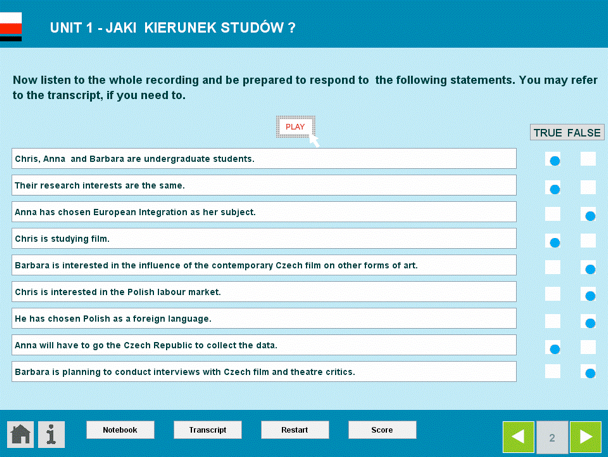
A Journey Through Online
Language Learning
Mode of Delivery > Blended Learning
Blended learning refers to a learning situation which combines face-to-face and online elements. This is a very generic definition covering any number of learning contexts which may vary in terms of
- the size and scope of the online element
- the skills covered by the online element
- the nature and purpose of the online element, e.g. types of activities offered
- whether or not the online element includes an element of tutor-support
Size and scope of the online element
The online element may make up only a relatively small part of the entire learning situation, e.g. only offering self-correcting exercises for vocabulary and grammar. The Lagelands Beginners Grammar, for example, might be implemented in this way. Equally, the online component can be much more substantial, covering a range of skills and activities, including those requiring tutor-support. Both Lagelands and Hogelands are used this way, by the Universities of Hull and Sheffield respectively. One contributing factor in determining the size and scope of the online component is likely to be the amount of face-to-face contact offered by the course.
Another way in which the scope of the online element may vary is the extent to which it is integrated with the face-to-face component. The online materials may be offered as a completely ‘stand-alone' element without any tutor-support, as is the case for the Polish course, where the listening and speaking elements are covered online by means of self-correcting exercises, and the face-to-face element focuses on reading and grammar. However, unless such a stand-alone online component serves a very clear and specific purpose (as in this case), it is unlikely to work very well, as students may well fail to see the connection between it and the face-to-face component. In fact, integration is one of the key elements of success in blended learning.
Skills covered by the online element
Traditionally, the skills covered by the online element are the receptive skills of reading and listening, as well as the sub-skills of vocabulary and grammar, as these can be dealt with by means of self-correcting exercises, such as in the case of Lagelands, Hogelands and the Polish course.
Example of a self-correcting listening exercise in Polish Listening and Speaking.
Writing, too, can be offered online, either using model answers for self-correction or feedback from the tutor and / or the students' peers.
Generally, though, speaking is considered to be best covered in class, this being more ‘realistic'. With the advances in technology, particularly the increased stability and hence reliability of such applications as Skype and Wimba voice-boards, however, it is these days also perfectly possible to cover speaking online. In fact, in some instances, e.g. for practising telephone conversations (example from Lagelands) or leaving messages on an answerphone / voicemail, this may be more realistic than the ‘in-class' option.
Nature and purpose of the online element
The types of activities which can be offered online are manifold, and reach far beyond the by the now ‘standard' multiple-choice, gap-fill and matching exercises. Admittedly, this is dependent to some extent on the availability of tutor-support, but even just using model answers gives much more scope for creativity.
One key reason for incorporating an online element in a language course is that it enables the tutor to exploit authentic materials, which may be particularly relevant for less widely used and taught languages. The use of authentic materials does not automatically imply a need for tutor-support, witness the following example.
Whilst an online component may be introduced to cover skills which cannot be covered in class due to time constraints (such as in the Polish course), to provide more structured homework opportunities or to increase access to authentic materials, it may also be used to offer opportunities for remedial work (example3 from Lagelands) or extension.
Tutor-support
As will be clear from the above, whether or not tutor-support is available for the online element will be highly significant in determining the nature, scope and skills covered. It therefore pays to give the amount of tutor-support you are willing and able to offer careful consideration at the start of the development process.

Things to consider
-
-What is the purpose of the online component? Is it to cover skills which cannot be dealt with in class, to provide structured homework, access to authentic materials or remedial / extension work?
-
-What are you going to offer online and what are you going to offer face-to-face? If you are starting from an existing course / module, the learning outcomes may be a good place to start. Another determining factor may be the amount of face-to-face contact offered by the course.
-
-How much online tutor-support are you willing and able to offer? This will particularly affect the skills and types of activities you are able to cover online.
-
-How are you going to combine the online and face-to-face elements? How are you going to ensure that students see the connection between the two? Remember: integration is key!
Examples:
- Polish Listening and Speaking
Further reading
Van Rossum, M. (2003), ‘On-line and face-to-face language learning compared: the student experience.’ Paper presented at Setting the Agenda: Languages, Linguistics and Area Studies in Higher Education Conference, Manchester: 24-26 June 2002. http://www.lang.ltsn.ac.uk/resources/conferenceitem.aspx?resourceid=1386 (Please note that this article relates to the first version of Lagelands)
Disclaimer I Freedom of Information I Accessibility I Contact Us
University College London, Gower Street, London, WC1E 6BT Tel: +44 (0) 20 7679 2000
© UCL 1999–2011
